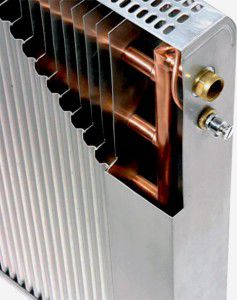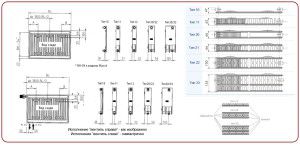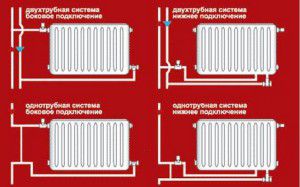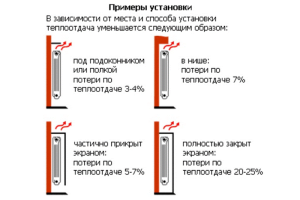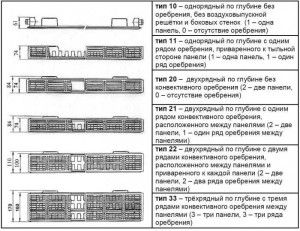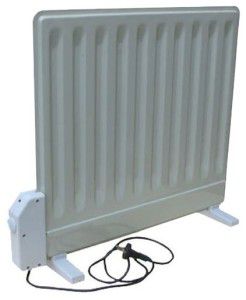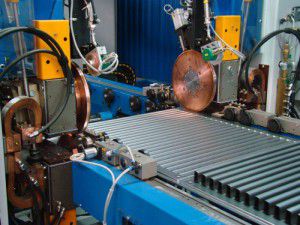The use of steel panel radiators to complete the heating system is due to several factors. First of all, their high heat dissipation. Thanks to a well-thought-out design and unique technical properties of the material of manufacture, it is possible to choose the optimal panel batteries and heating radiators: steel, electric.
The main advantages of panel radiators
First you need to figure out how steel panel heating batteries differ from similar aluminum and bimetal ones. Structurally, these heat supply devices are vertical channels for the coolant, which are connected to the outer panels using heat transfer plates.
Because of this structure, panel radiators have a number of important distinctive advantages:
- Low degree of inertia of work. Warming up the outer surface is much faster than cast iron counterparts. For additional air convection, special targets are provided in the upper lower part of the structure. Through them, air circulation and its further heating;
- Reliability. Unlike sectional radiators, panel radiators have much less mechanical joints, which increases their level of reliability;
- Light weight. For fastening, the simplest models are used brackets for panel radiators. This has a positive effect on cost.
However, along with these qualities, it is necessary to take into account the disadvantages that steel panel radiators have. First of all, they include susceptibility to corrosion. If the coolant acidity is at a high level, and also a large amount of oxygen is observed in it, there is a high probability of rust on the inner walls of the devices. In addition to this, panel heating is not recommended for a long time without water.
In some steel panel radiators, the internal channels are made of copper pipes. This increases corrosion resistance, but also significantly increases the cost.
Panel Battery Features
For the consumer, several indicators of heating devices are important. They must be adapted to the parameters of the current heat supply system. That is why it is necessary to know the main technical characteristics of panel heating radiators.
Despite the apparent strength of these devices - they are not recommended for installation when completing a central heating system. This is due to the maximum pressure in the pipes. For panel heating, the following parameters must be observed:
- The maximum pressure in the heating system is up to 10 atm. Some models are able to withstand short-term up to 13 atm;
- The temperature of the coolant should not exceed + 110 ° C. In practice, Prado panel radiators are installed in a system where this figure exceeds + 90 ° C.
Regarding the design of the steel battery - special attention needs to be paid to 2 parameters. First of all, the thickness of the steel sheet. It should be at least 1.3 mm. For better protection against external influences, Russian panel heating radiators are powder coated. This technique allows to increase the service life of heat supply devices and counteracts the appearance of corrosion on their surface.
In the manufacturing process, a welding method is used to connect the individual structural elements. To ensure reliability, it is recommended to choose models with a continuous seam. The point connection does not contribute to the reliability of the structure during operation.
The operational technical characteristics of panel heating radiators include the type of connection:
- Side. The classic way to install batteries in a heating system. Well suited for vertical and horizontal piping;
- Lower. The best option for concealed pipelines. However, it may be difficult to install the thermostat, with which you can adjust the power of the panel heating radiators.
To transfer thermal energy to the surface of the pipelines, heat transfer plates are welded. They are connected to a corrugated outer panel. The specific thermal return of the structure depends on their number and location. This indicator is indicated by the manufacturer in the passport. Heat transfer directly depends on the thermal mode of the heating system.
Panel electric heating radiators can be filled with coolant - water or oil. In the latter case, the time to reach the optimum temperature is long, but subsequent cooling after turning off the device will be much slower.
Design features of radiators
Unlike sectional, for panel heating batteries, an essential parameter is the total external surface area. Together with the characteristics of the source of thermal energy (water in pipes or electric heating elements), it determines the technical qualities of the heating device.
When choosing, you need to focus on certain parameters inherent in steel panel heating radiators. These include:
- Overall dimensions - width, height and depth. These characteristics determine the thermal return of the device;
- The number of rows of heat transfer plates;
- Pipe capacity. The volume of coolant placed in one radiator depends on this.
For a detailed analysis, it is necessary to consider the design features of each type of heating device - for a water heating system and electrical models.
When purchasing a certain model of a heating device, it is necessary to check its configuration. It must include brackets for panel radiators.
Steel panel batteries for water heating
When choosing, it is necessary to determine the overall dimensions of the steel heating panel batteries. This parameter depends on the required power of the device and the place of its installation. Most often, radiators are mounted in special wall niches under window structures.
Currently, manufacturers offer heating panel batteries with the following sizes:
- Height. Varies from 20 to 90 cm;
- Length. It can be from 40 cm to 3 m. They prefer to install the latter when organizing panel heat supply of large rooms.
The depth of the radiator directly depends on the number of heat exchange panels. This characteristic is indicated in the type of heating appliances. Apart from designer models with a characteristic appearance, there are the following types of steel panel heating batteries:
- 10 - have only a steel crate without a front panel. Relate to budget types;
- 11 - the structure of the structure includes one heat exchange unit and an external panel;
- 21 - two panels are installed on the block with water channels;
- 22 - to increase the power of panel heat supply batteries, another heat exchanger is additionally mounted;
- 33 - the radiator consists of three panels and 3 heat exchange panels.
In addition to these technical characteristics of panel heating batteries, when choosing a design, it is recommended to pay attention to the design of the front panel. Some manufacturers make them corrugated to increase the heating area. Thus, maximum heat transfer is achieved without significantly exceeding the dimensions of the battery.
During the installation of Prado panel radiators, the minimum distance from the lower surface of the structure to the floor must be observed. Otherwise, air convection rates may deteriorate significantly.
Panel-type electric heating batteries
Unlike water models, panel electric heating radiators are made using a different technology. For this, the geometry of the steel sheet is previously changed by pressing. Then, using spot welding, they are connected to each other, forming a single structure. In this case, channels are formed inside which are filled with coolant.
However, this manufacturing method is the cause of some disadvantages. First of all, they include the large dimensions of the structure. To heat the coolant, it is found to install heating elements. Due to the specific design, this can be done either from the side or from the bottom. Therefore, the vast majority of these panel electric heating radiators are of the floor type. Those. they cannot be attached to the wall due to the large dimensions.
To solve this problem, other types of electric panel heating batteries have been developed. They consist of a steel duct with convection slots. Inside it are heating elements.
This design has several advantages:
- Ability to install on the wall;
- High degree of convection of air for its heating;
- For modern models, the package includes operation control devices (thermostat) and a heater shutdown unit in the event of a rollover of the radiator or a sudden power surge.
Radiators are installed using special brackets for panel radiators.
Fasteners in the form of flat plates should be located on the rear panel of the structure. If brackets are not included in the radiator’s package, you must first measure the fasteners on the radiator panel and then select the optimal design of the mounting elements according to the dimensions obtained.
If a panel-type electric radiator will be installed in the bathroom, it is necessary that the outer casing is waterproof in its design.
Overview of manufacturers and prices for panel radiators
Currently, there are several manufacturing companies that specialize in the production of panel radiators. Their products are of high quality, reliable performance and long life.
These positive characteristics apply to many Russian panel heating radiators. For the correct choice of the optimal model, in addition to the characteristics, it is necessary to make an initial price analysis.
| Manufacturer / Model | Power, W | price, rub. |
| Kermi FKO type 11 L - 400 | 474 | 2920 |
| Korado Radik Type 11 L - 300 | 355 | 1800 |
| Prado Classik Type 11 L - 500 | 376 | 1950 |
| Prado UIniversal Type 11 L - 500 | 376 | 3145 |
In addition to technical indicators, it is necessary to take into account the complete set of radiators and a guarantee for their work. Based on the latter, it is best to choose a domestic manufacturer with a large network of specialized service and repair points.
For those who decide to install the radiator on their own - it is useful to watch a video where this process is described in detail:
